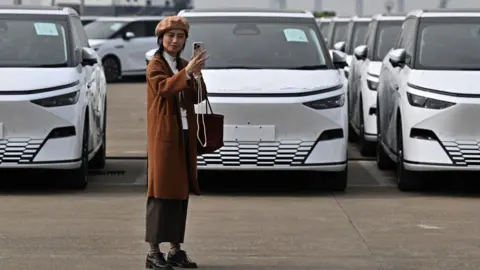**How China Made Electric Vehicles Mainstream**
In recent years, China has transformed electric vehicles from a niche market into a mainstream choice for millions of consumers. Reports indicate that nearly half of all cars sold in China in the past year were electric, a significant shift in the automotive landscape that contrasts starkly with many countries where electric vehicles (EVs) are still viewed as luxury items. This evolution in consumer choice represents not only a monumental change in transportation habits but also reflects broader societal shifts in perceptions about environmental responsibility and economic efficiency.
At the heart of this transformation are the voices of ordinary Chinese citizens like Lu Yunfeng, a private hire driver in Guangzhou. Lu candidly remarks, “I drive an electric vehicle because I am poor,” highlighting the financial incentive many experience when opting for EVs. His sentiments are echoed by fellow driver Sun Jingguo who cites the lower costs of operating an electric vehicle compared to conventional petrol-powered cars, stating, “It protects the environment” while leaning against his white Beijing U7. The primary motivator in these discussions appears to be economic—EVs are viewed as a cost-effective option, with many drivers saving significant money on fuel.
China’s journey to becoming a global leader in electric vehicles commenced at the turn of the century when the government set ambitious targets to dominate future technologies. As Michael Dunne, an auto sector analyst, noted, “When it comes to EVs, China is 10 years ahead and 10 times better than any other country.” This technological supremacy has resulted in cities like Guangzhou, home to over 18 million people, experiencing a significant reduction in traditional automotive noise, replaced by the hum of electric motors.
BYD, a prominent Chinese automobile manufacturer, has emerged as a leader in global EV sales, surpassing US rival Tesla and positioning itself to expand sales internationally. With a domestic market of over 1.4 billion people, BYD’s success is often attributed to a supportive government ecosystem that includes both financial incentives and infrastructure development. This foundation has paved the way for many new startups, providing them with opportunities to capture the growing segment of budget-conscious consumers seeking electric alternatives.
Yet, the genesis of this EV boom can be traced back to 2007 and the efforts of Wan Gang, a German-trained engineer who was pivotal in formulating China’s electrification strategy. As the former Minister of Science and Technology, Wan recognized the urgent need for China to transition from reliance on foreign car brands to developing its own electric vehicle industry. The government subsequently allocated billions in subsidies—over $231 billion from 2009 to 2023—to encourage both manufacturers and consumers to favor electric mobility over fossil fuel dependence.
This significant financial backing facilitated the creation of a robust supply chain for electric vehicle production, especially in the battery sector dominated by companies like CATL. Moreover, the Chinese government has actively constructed the world’s largest public charging network, with charging stations conveniently located across urban areas to ensure accessibility for EV owners.
In stark contrast to the regulatory environments in Western democracies, which often impede rapid transitions, China’s centralized decision-making has allowed the country to align its economic resources toward this singular goal. Competitive practices, combined with abundant local talent and an aggressive push for innovation, have resulted in a vibrant ecosystem of EV startups that drive the industry forward.
As experienced with brands like XPeng, the entry of younger, tech-savvy entrepreneurs has revamped consumer expectations. The atmosphere in their offices resembles that of Silicon Valley, featuring amenities aimed at attracting the nation’s brightest minds. This cultural shift within the automotive sector promotes innovation and pushes the boundaries of what consumers now expect—from self-driving technologies to streamlined features integrated within vehicle designs.
With government initiatives that provide considerable financial advantages, potential buyers are lured into transitioning to electric vehicles. Subsidies help to offset costs, making electric cars financially attractive compared to their internal combustion counterparts. Lu Yunfeng, for instance, benefits from the free registration plates provided to electric car owners, creating a favorable economic environment for EV purchases.
However, this rise in EV adoption in China is met with apprehension from Western nations, many of which have implemented tariffs on Chinese electric vehicles while strategizing to safeguard their own automotive industries. Nonetheless, China’s prowess in EV technology, production, and infrastructure places it in a unique position to potentially dictate global trends in sustainable transport.
As other nations advance toward banning petrol and diesel vehicles by 2030, China remains at the forefront of shaping this transition, leading the electric vehicle charge on a global scale. The competitive landscape fostered in China raises questions about alternative markets and their capacity to compete, while simultaneously presenting opportunities for collaboration in addressing climate crises. The trajectory of EV adoption, fueled by government support and consumer readiness, reflects China’s readiness to redefine the future of transportation, urging the world to acknowledge its contributions to electric mobility and environmental stewardship.



